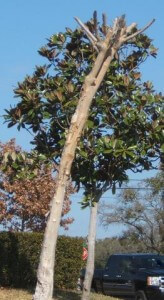
I love to garden and I love to see plantings that are well nurtured, well taken care of. These photos, taken today in Cedar Park, Texas are the opposite of what I like to see. I, like so many others call this “Crepe Murder”. The butchering of Crepe Myrtles is also called topping and is not the correct way to prune and nurture this beautiful botanical species. Crepe Myrtles bloom all summer long, providing shade and beauty to our Central Texas landscapes. Crepe Myrtle varieties are available with many different colors of flowers. White, pink, lavender and red are some of the most popular bloom colors. In the winter, their deciduous leaves fall and they allow the sun to shine in. The least we can do is provide them the minimal care they need to live long and healthy lives. Committing Crepe Murder leaves the poor plants in a weakened state, more susceptible to disease, drought and other life threatening and life shortening events. This bad practice not only makes them look like an ugly stump but also makes them bloom less. There are dwarf and semi-dwarf varieties if you want them to stay small. I like to allow the big ones to stretch out their limbs an provide abundant shade for my yard and home. Let’s reward Crepe Myrtles for their hard work and not make them ugly, heart broken and forlorn.
Properly Pruning Crepe Myrtles
Crepe Murder! There Oughta Be a Law!!!


I am still giggling at the title of your post! 🙂 Those poor crepe myrtles look so sad! I trim mine like you trim yours. I just love the color they produce in bloom!
I find that Crepe Myrtles are really popular these days as buyers talk more & more about wanting low-maintenance landscaping in their future homes. Thank you for providing the correct pruning tips!
Ouch. Central Austin home owners, please take care of your natural assets too!
This breaks my heart (and makes me mad). They should just cut the poor things down now. Thanks for posting this, Betty! This is information that needs to be widely distributed so that others don’t make this mistake when pruning.
This is great advice, Betty for so many people who feel compelled to shear the tops off their crepe myrtles just because that’s the way their neighbors or, worse yet, a landscaping service did it that way at the local park. The late winter timing is critical since crepes bloom on this year’s new growth as do Abelia, Butterfly Bush and most Rose species and varieties. Other shrubs that bloom on last year’s growth should not be pruned until after they bloom in season. These include Redbuds,Japanese Quince, Forsythia, Honeysuckle, Indian Hawthorn, Azaleas, Rhododendrons and some climbing and rambling rose species. Pruning, whenever it occurs, provides a stimulant to the tree, shrub or plant to produce more vigorous growth to replace that which has just been removed.